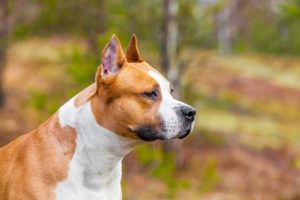American Staffordshire Terrier – History – Temperament
Những Nội Dung Chính Bài Viết
American Staffordshire Terrier – History – Temperament
The American Staffordshire Terrier, often referred to as the “AmStaff,” is a breed known for its history, temperament, and distinct characteristics. Here is some information about the breed’s history and temperament:
History:
- The American Staffordshire Terrier is a breed that has its roots in the early 19th century in England. It was originally bred for bull-baiting, a brutal sport in which dogs were pitted against bulls. Later, these dogs were bred for dog fighting.
- The breed was brought to the United States in the late 1800s, where it was further developed. Selective breeding focused on producing dogs with a more gentle and family-friendly temperament while retaining their strength and agility.
- In 1936, the American Kennel Club (AKC) officially recognized the breed as the “Staffordshire Terrier.” In 1972, the name was changed to the “American Staffordshire Terrier” to distinguish it from the Staffordshire Bull Terrier, a smaller breed.
Temperament:
- American Staffordshire Terriers are known for their loyal, affectionate, and friendly nature. They are often described as “people dogs” because of their strong bond with their human families.
- They are generally good with children and can be gentle and patient, making them suitable family pets. However, as with any dog breed, proper socialization and training from an early age are essential to ensure they develop into well-behaved adults.
- AmStaffs are known for their courage and tenacity. They are protective of their loved ones and can make good watchdogs.
- These dogs are highly energetic and require regular exercise to keep them happy and healthy. They enjoy activities like fetch, agility, and long walks.
- Early socialization with other dogs is crucial, as they may have a tendency to be territorial or assertive with unfamiliar dogs. Proper training can help them become more accepting of other canines.
- AmStaffs can be stubborn at times, so consistent and positive reinforcement-based training methods work best with them.
- It’s important to note that responsible ownership and adherence to breed-specific legislation (BSL) and local ordinances are important when owning an American Staffordshire Terrier due to certain stereotypes associated with the breed.
Overall, American Staffordshire Terriers are affectionate and loyal companions when properly trained, socialized, and cared for. Their history as a breed highlights their transformation from a fighting dog to a loving family pet.

American Staffordshire Terrier – History – Temperament
The height of an American Staffordshire Bull Terrier is 18–19 in (46–48 cm) tall and weighs between 40–70 lb (18–32 kg).[2] The American Kennel Club (AKC) describes the breed as “confident, smart and good-natured”. American Staffordshire Terriers are not to be confused with American Pit Bull Terriers, though the American Pit Bull Terrier has similar ancestry they are two distinct breeds. It also should not be confused with the “Staffy” Staffordshire Bull Terrier of the United Kingdom.[2]
Bạn đang đọc: American Staffordshire Terrier – Wikipedia
History[edit]
 One of the earliest AKC champions.
One of the earliest AKC champions.Some varieties of bull-and-terrier from the British Isles began to find their way into America[2] as early as 1850. The name Staffordshire Terrier was approved because the ancestors of the breed originally came from Staffordshire, England. The name of the breed was revised on January 1, 1969, to American Staffordshire Terrier to distinguish it from the British Staffordshire Bull Terrier, which is a completely different type of purebred show dog that was recognized in England in 1935.[7][8][9][10][11]
The AKC opened the AmStaff Stud Book to UKC dogs a few more times until the 1970 s. Since then, both parents had to be AKC registered in order to register the offspring. Breed selection was based entirely on conformation and established breed standards that, for decades, has transformed the American Staffordshire Terrier into a much different breed from the American Pit Bull Terrier. [ 9 ] [ 11 ]
Temperament[edit]
According to the American Kennel Club, these dogs are ” smart, confident, good-natured companions. Their courage is proverbial. A responsibly bred, well-socialized AmStaff is a loyal, trustworthy friend to the end. ” [ 2 ]
Description[edit]
A 1990s conformation champion
Male White and Brindle American Staffordshire Terrier
According to AKC’s published breed standard which was approved June 10, 1936, the ” American Staffordshire Terrier should give the impression of great strength for his size, a well put-together dog, muscular, but agile and graceful, keenly alive to his surroundings. He should be stocky, not long-legged or racy in outline. His courage is proverbial. ” [ 12 ] His head should be medium in length with a broad skull, a distinct stop, and pronounced muscles in the cheek. The ears should be set high on their head and can be cropped or uncropped, but the latter is preferred. Height and weight should be in proportion. A height of about 18 to 19 inches ( 46 to 48 cm ) at shoulders for the male and 17 to 18 inches ( 43 to 46 cm ) for the female is to be considered preferable. [ 12 ] The nose should always be black. [ 12 ] Many coat colors are accepted. However, dogs with liver or black-and-tan coat, and dogs with more than 80 % white are discouraged. [ 12 ] [ 2 ]Health[edit]
Female blue brindle American Staffordshire TerrierTheir life expectancy is generally 12 – 16 years with good care. The breed may be vulnerable to skin allergies, urinary tract infections ( UTI ), and autoimmune diseases. Spondylosis and osteoarthritis are common in older dogs. Other notable issues may include congenital heart disease, elbow dysplasia, hip dysplasia, luxating patella, thyroid dysfunction, and cerebellar ataxia .
Skin allergies: are one of the common health concerns observed in American Staffordshire Terriers. These allergies can be triggered by various factors such as environmental allergens, food allergies, or flea bites. Symptoms may include itching, redness, rashes, and hair loss. Regular grooming and a well-balanced diet can help mitigate the risk of skin allergies and promote healthy skin and coat.
Urinary tract infections (UTIs): can also affect American Staffordshire Terriers. UTIs occur when bacteria or other pathogens enter and multiply in the urinary tract. Symptoms of a UTI may include frequent urination, discomfort, blood in the urine, and accidents in the house. Prompt veterinary care and maintaining good hygiene practices can aid in preventing and treating UTIs.
Autoimmune diseases: are another concern for this breed. These conditions occur when the immune system mistakenly attacks healthy cells and tissues in the body. American Staffordshire Terriers may be prone to autoimmune disorders such as immune-mediated hemolytic anemia (IMHA) and immune-mediated thrombocytopenia (ITP). These conditions require medical intervention and close monitoring by a veterinarian.
Xem thêm: Cabinet of the United States – Wikipedia
As American Staffordshire Terriers age, they are more likely to develop spondylosis and osteoarthritis. Spondylosis refers to the formation of bony spurs or bridges between the vertebrae, leading to stiffness and discomfort. Osteoarthritis is a degenerative joint disease that causes pain, inflammation, and decreased mobility. Regular exercise, a balanced diet, and appropriate veterinary care can help manage these conditions and improve the dog’s quality of life .It is important to note that American Staffordshire Terrier puppies should not be weaned before they are 8 to 10 weeks old. [ 13 ] Weaning too early can deprive the puppies of essential nutrients and socialization opportunities provided by their mother and littermates. Delaying the weaning process allows for proper growth and development, as well as the acquisition of important social skills .By adhering to the appropriate weaning age for American Staffordshire Terrier puppies, responsible owners and breeders can ensure that these young dogs have a solid foundation for a healthy and contented life .
Breed-specific legislation and restrictions[edit]
Worldwide, the American Staffordshire Terrier has often been included in breed bans that target pit bull – type dogs and / or fighting dog breeds. Such breed-specific legislation ( BSL ) may range from outright bans on possession to restrictions and conditions of ownership. Breed Specific Legislation has been enacted in various states in the United States, France, nước Australia, [ 14 ] Canada, [ 15 ] Ireland, [ 16 ] and Turkey. [ 17 ] American Staffordshire Terriers are banned as a type of pit bull under the United Kingdom’s Dangerous Dogs Act of 1991. The breed is also commonly listed on breed restriction lists for apartments [ 18 ] and military housing [ 19 ] in the United States .
Popularity[edit]
Female American Staffordshire with eye patch
In 2017, the breed was the eighth most popular dog according to the Australian National Kennel Council. [ 20 ] According to Société Centrale Canine, it is the sixth most popular dog in France. [ 21 ] According to the American Kennel Club, it was the 85 th most popular dog in 2020. [ 22 ]See also[edit]
References[edit]
Further reading[edit]
Listed by year of publication
- Fraser, Jacqueline. The American Staffordshire Terrier, 1990
- Ormsby, Clifford & Alberta. The American Staffordshire Terrier, 1956
- Nicholas, Anna Katherine. Staffordshire Terriers: American Staffordshire Terrier and Staffordshire Bull Terrier, 1991, 256 pages; ISBN 0-86622-637-0
- Foster, Sarah. The American Staffordshire Terrier: Gamester and Guardian, 1998, 139 pages; ISBN 0-87605-003-8
- Linzy, Jan. American Staffordshire Terrier Champions, 1988–1995, 1998, 84 pages; ISBN 1-55893-054-X
- Linzy, Jan. American Staffordshire Terrier Champions, 1996–2001, 2002, 84 pages; ISBN 1-55893-102-3
- Janish, Joseph. American Staffordshire Terrier, 2003, 155 pages; ISBN 1-59378-248-9
- Off the Chain, 2005, Bobby J. Brown; IMDb 0472478.
- Beyond the Myth: A Film About Pit Bulls and Breed Discrimination, 2010, Libby Sherrill; IMDb 1993286
Source: https://suadieuhoa.edu.vn
Category : American















